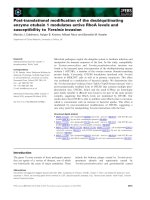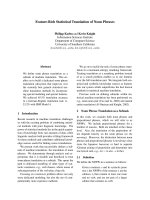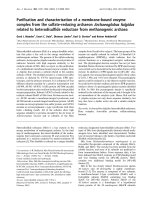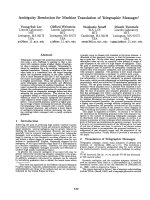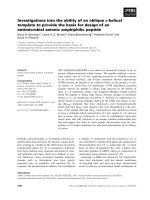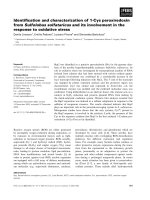Báo cáo khoa học: "DEVOTED TO THE TRANSLATION OF LANGUAGES BY THE AID OF MACHINES" pot
Bạn đang xem bản rút gọn của tài liệu. Xem và tải ngay bản đầy đủ của tài liệu tại đây (99.24 KB, 2 trang )
[Mechanical Translation, Vol.7, no.2, August 1963]
mechanical translation
Vol. 7, No.2
DEVOTED TO THE TRANSLATION OF LANGUAGES BY THE AID OF MACHINES August, 1963
Annual Meeting
The Association for Machine Translation and Com-
putational Linguistics will hold its first annual meeting
in the Denver Hilton Hotel, August 25 and 26. The
Association meets in alternate years in conjunction with
a major computer conference and a major linguistics
conference. This year the dates were chosen so that the
meeting would take place the two days immediately
preceding the ACM National Conference in the same
hotel. It is expected that many of the persons attending
one meeting will also attend the other. The program
for the two-day meeting includes thirty-four papers.
Four foreign countries are represented, although the
bulk of the papers come from the United States.
The secretary for the meeting is Professor H. H.
Josselson, Wayne State University, Detroit 1, Michigan.
The papers cover a wide variety of topics, including
syntactic analysis, semantics, particulars of languages,
theoretical linguistics, research procedure and tech-
niques. Abstracts of the papers follow in this issue of
MT.
The Association for Machine Translation and Com-
putational Linguistics was formed about a year ago by
a number of people interested in the problem of trans-
lating languages by machine. The interest of the Asso-
ciation covers a broader field, however, including the
use of computers for language processing in general.
Report from Hungary
The first Hungarian “Conference on mathematical
linguistics and mechanical translation” was held March
8-10, 1962, in Budapest. The conference was organized
by the Institute of Linguistics of the Hungarian Acad-
emy of Sciences (HAS), in collaboration with the Presi-
dential Committee of Cybernetics and the Working
Committee of General Linguistics, both of HAS. The
first day was devoted to mathematical and statistical
linguistics; the second, to mechanical translation and in-
formation retrieval; and the third, to a general dis-
cussion concerning plans, projects, publications, etc.
The conference had a national character; no foreign
guests participated, and all papers and discussions were
in Hungarian. There were more than forty active par-
ticipants in the discussions. The entire proceedings will
be published in 1963 by HAS (Akadémiai Kiadó, Buda-
pest).
The colloquium “Foundations of mathematics, math-
ematical machines, and their applications,” organized by
the János Bolyai Mathematical Society and held in
Tihany, September 11-15, 1962, had a section on
“mathematical linguistics and machine translation.” The
proceedings of this colloquium will be published in
1963 by HAS (Akadémiai Kiadó, Budapest) and by
Gauthier-Villars (Paris).
Some of the principal Hungarian groups currently
active in mechanical translation and mathematical
linguistics are:
(1) Institute of Linguistics of HAS, Group for General
and Structural Linguistics. Director: Prof. Zsig-
mond Telegdi. Recently founded group, engaged
in research on transformational grammar of Hun-
garian.
(2) Computing Center of HAS. Director: Ferenc
31
Kiefer. In 1961, this group conducted the first ex-
periments on an M-3 Hungarian-built computer.
The group sponsors an MT seminar, organized in
April, 1962. Meetings are held regularly every
fortnight, and are attended by mathematicians and
linguists of different institutions. The Center plans
to form an official MT group in 1964.
3) Debrecen Group for Mathematical and Applied
Linguistics. Director: Ferenc Papp. This group
conducts statistical investigations of Hungarian
and Russian texts. Also, they are investigating
linguistic aids for foreign language teaching, and
are doing preparatory work for Czech-Hungarian
MT, and theoretical work on models. Papp holds a
seminar in quantitative linguistics. The prospect is
that this group will form an official liaison with
HAS.
(4) Technical University of Budapest, Institute of
Languages. Includes a group, headed by György
Hell, working on Russian-Hungarian MT, and
planning to work on English-Hungarian MT.
In addition, there are many persons, some of whom
are not associated directly with the above-mentioned
groups, who are working on related problems. There
are plans to form shortly a working committee of HAS,
for the purpose of theoretically co-ordinating all of the
Hungarian work in MT and mathematical linguistics.
György Szépe
November, 1962
32

